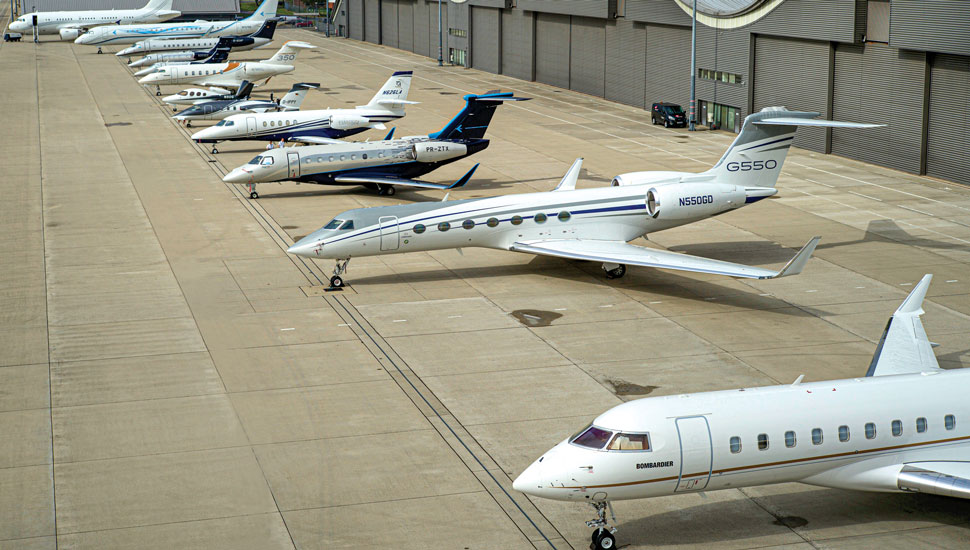A major push towards encouraging business aviation to meet stringent carbon dioxide (CO2) emission targets and to change the perception of the industry's environmental footprint is at the core of this year's EBACE.
More than a dozen business aircraft made a high-profile entry to the show from TAG Farnborough over the weekend, all fuelled by sustainable alternative jet fuel (SAJF).
A global coalition of business aviation organisations had gathered ahead of the fly-out to highlight the path forward for continued adoption of SAJF during the day-long event.
But European Business Aviation Association secretary-general Athar Husein Khan warned that to achieve targets there needs to be greater involvement by industry and governments.

A dozen jets powered from sustainable sources line up at Farnborough
EBAA
With the EBACE-bound jets and turboprops lining up on the Farnborough ramp awaiting the World Fuel Services bowsers, Khan said: "Uplifting this fuel was no easy task. Market availability still leaves a lot to be desired. Costs are more, but decreasing slowly. We need regulators to step in and help industry take steps towards a carbon-neutral future.”
The cost of the alternative fuel is currently around three times the cost of Jet A1, and although he recognises that business aviation and particularly corporate flight departments would be prepared to pay a premium for the environmental benefit Khan says there still needs to be a reduction in price.
"We need a bit more market pressure on the system," Khan said. "I would expect and hope that operators will put a bit more pressure on their fuel suppliers and fuel manufacturers to actually produce more of the fuel and have a more appropriate geographical spread.
"We have seen governments incentivising the use and the production of alternative fuels for automotive. There are ample European programmes with respect to fiscal incentives and funds available for research and development. We are certainly calling on European regulators to make that available for SAJF as well."
Bombardier president David Coleal said it is imperative the industry reacts. "The challenge we have to do is make sure that the supply and therefore the utilisation of SAJF is adopted rapidly, because we don't want to get so far behind that the adoption rate is slower than we want, and therefore impact on the target."
Tim Obitts, chief operating officer of the National Air Transportation Association (NATA) said there are greater benefits from adopting the fuel. "Right now, we're looking at fuels that get up to 50% reduction in carbon emissions. But there are now some approaches where we are looking at some fuels that could get us up to 80% reductions, which is really significant."
Coleal agrees. "The great thing about SAJF is that it's drop-in ready. In theory and in practice, there's no difference from a safety perspective or from a performance perspective. We're finding it actually performs better than Jet A1 and has better performance aspects with CO2 reductions, while performing with better fuel economy.
Khan will be opening the EBACE conference tomorrow morning and will be joined by industry leaders and politicians with SAJF high on the agenda. "SAJF is essential for the future of this industry. Business aviation is committed to a carbon-neutral future from 2020 onwards, in addition to a net carbon reduction from 2050 onwards, so SAJF is a key component of that target and ambition."
He also urged business aviation professionals to help change public perception of the use of private jets.
"It's all up to the industry to tell our story. We need to be very effective and very transparent about what we can do, what we can achieve, but also where our concerns and challenges are – if we do that, and constantly inform the public politicians and regulators, I would imagine that in the future, the discussion would be a bit more balanced than it is today," he said.
2019EBACE
Find all the latest news, pictures, video and analysis from EBACE 2019 on our dedicated page.
latestnewsmainpage
Source: Flight Daily News























